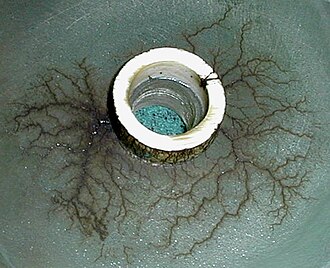Lichtenberg figure
Lichtenberg Figures: Patterns of Electrical Discharge[edit]
[[File:Lichtenberg figures generated by a sliding spark discharge.jpg |thumb|right|Lichtenberg Figure on an insulating material]]
Lichtenberg figures, named after the German physicist Georg Christoph Lichtenberg who originally discovered them, are intricate, branching patterns created by electrical discharges. These figures can appear on or within various materials like solids, liquids, and gases during electrical breakdowns.
Definition and Formation[edit]
Lichtenberg figures are branching electric discharges that can form on the surfaces or within the interiors of insulating materials. They occur when high voltage affects a material, causing a breakdown and leaving behind a distinctive, tree-like pattern.
Types and Characteristics[edit]

There are two primary types of Lichtenberg figures:
- Planar Lichtenberg figures, which spread along the surfaces of insulating materials.
- 3D electrical trees, which form within insulating materials.
Each type provides unique visual evidence of the paths taken by electrical discharges.
Association with High Voltage Equipment[edit]
Lichtenberg figures are commonly associated with the deterioration of high-voltage components and equipment. They are often indicative of areas where electrical insulation has been compromised.
Applications in Engineering[edit]
The study of Lichtenberg figures is important for engineers, particularly for enhancing the reliability and safety of high-voltage equipment. Analyzing these patterns helps in understanding the material's behavior under stress and improving insulation design.
Safety Considerations[edit]
While Lichtenberg figures can be artificially created for artistic purposes, the process involves high voltage and is hazardous. Safety precautions are necessary to prevent electrical accidents.
Lichtenberg Figures in Nature and Art[edit]

In nature, Lichtenberg figures are sometimes observed in the form of lightning strike scars on surfaces. Artists also use high-voltage electrical discharges to create Lichtenberg figures in materials like wood and acrylic for decorative purposes.
See Also[edit]
References[edit]
<references>
</references>
External Links[edit]
Ad. Transform your life with W8MD's Budget GLP-1 injections from $75


W8MD offers a medical weight loss program to lose weight in Philadelphia. Our physician-supervised medical weight loss provides:
- Weight loss injections in NYC (generic and brand names):
- Zepbound / Mounjaro, Wegovy / Ozempic, Saxenda
- Most insurances accepted or discounted self-pay rates. We will obtain insurance prior authorizations if needed.
- Generic GLP1 weight loss injections from $75 for the starting dose.
- Also offer prescription weight loss medications including Phentermine, Qsymia, Diethylpropion, Contrave etc.
NYC weight loss doctor appointmentsNYC weight loss doctor appointments
Start your NYC weight loss journey today at our NYC medical weight loss and Philadelphia medical weight loss clinics.
- Call 718-946-5500 to lose weight in NYC or for medical weight loss in Philadelphia 215-676-2334.
- Tags:NYC medical weight loss, Philadelphia lose weight Zepbound NYC, Budget GLP1 weight loss injections, Wegovy Philadelphia, Wegovy NYC, Philadelphia medical weight loss, Brookly weight loss and Wegovy NYC
|
WikiMD's Wellness Encyclopedia |
| Let Food Be Thy Medicine Medicine Thy Food - Hippocrates |
Medical Disclaimer: WikiMD is not a substitute for professional medical advice. The information on WikiMD is provided as an information resource only, may be incorrect, outdated or misleading, and is not to be used or relied on for any diagnostic or treatment purposes. Please consult your health care provider before making any healthcare decisions or for guidance about a specific medical condition. WikiMD expressly disclaims responsibility, and shall have no liability, for any damages, loss, injury, or liability whatsoever suffered as a result of your reliance on the information contained in this site. By visiting this site you agree to the foregoing terms and conditions, which may from time to time be changed or supplemented by WikiMD. If you do not agree to the foregoing terms and conditions, you should not enter or use this site. See full disclaimer.
Credits:Most images are courtesy of Wikimedia commons, and templates, categories Wikipedia, licensed under CC BY SA or similar.
Translate this page: - East Asian
中文,
日本,
한국어,
South Asian
हिन्दी,
தமிழ்,
తెలుగు,
Urdu,
ಕನ್ನಡ,
Southeast Asian
Indonesian,
Vietnamese,
Thai,
မြန်မာဘာသာ,
বাংলা
European
español,
Deutsch,
français,
Greek,
português do Brasil,
polski,
română,
русский,
Nederlands,
norsk,
svenska,
suomi,
Italian
Middle Eastern & African
عربى,
Turkish,
Persian,
Hebrew,
Afrikaans,
isiZulu,
Kiswahili,
Other
Bulgarian,
Hungarian,
Czech,
Swedish,
മലയാളം,
मराठी,
ਪੰਜਾਬੀ,
ગુજરાતી,
Portuguese,
Ukrainian


